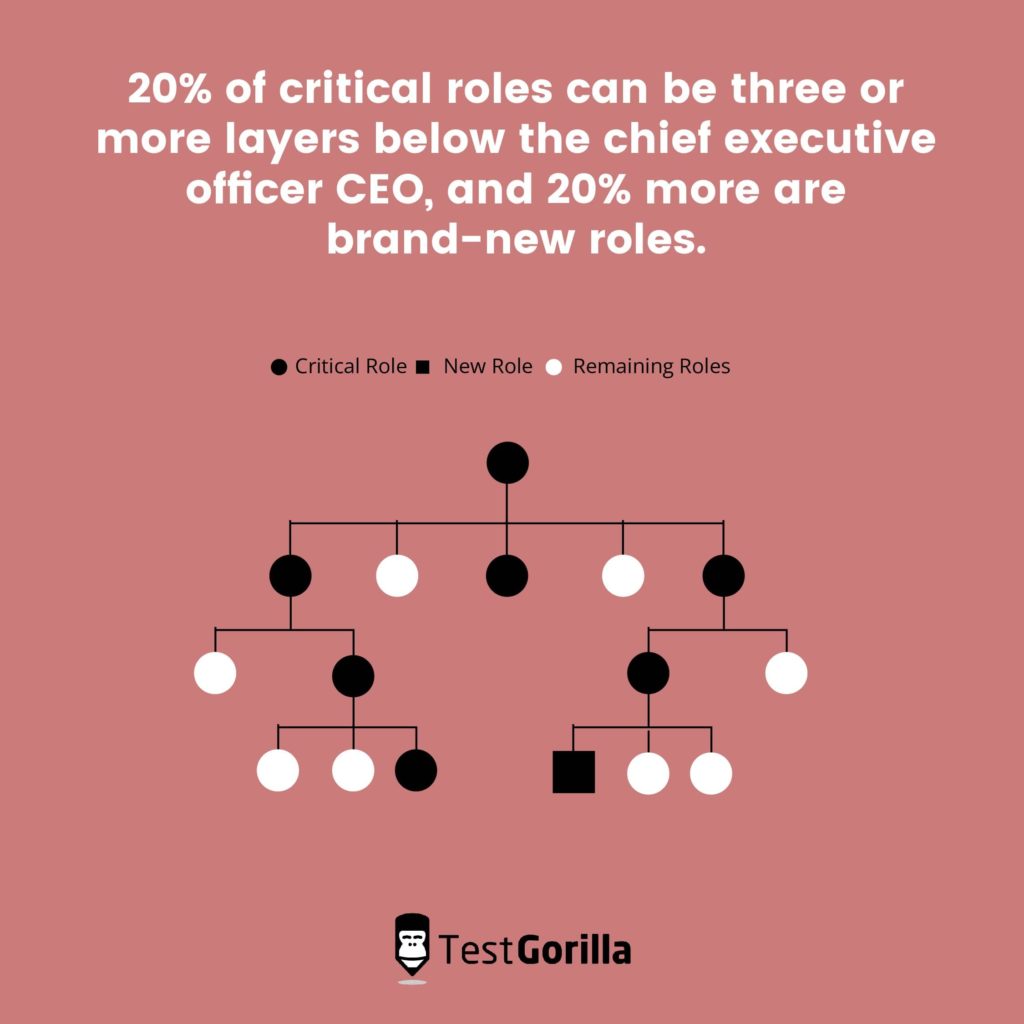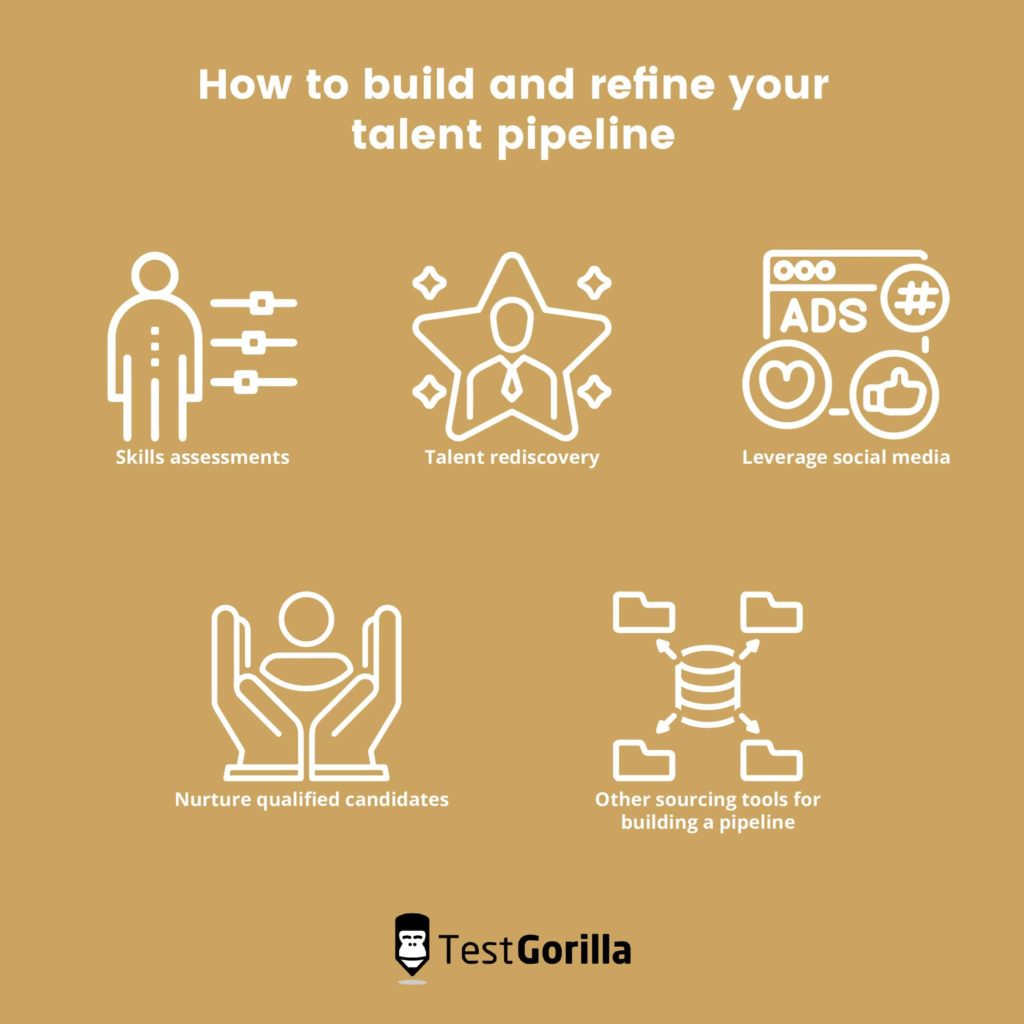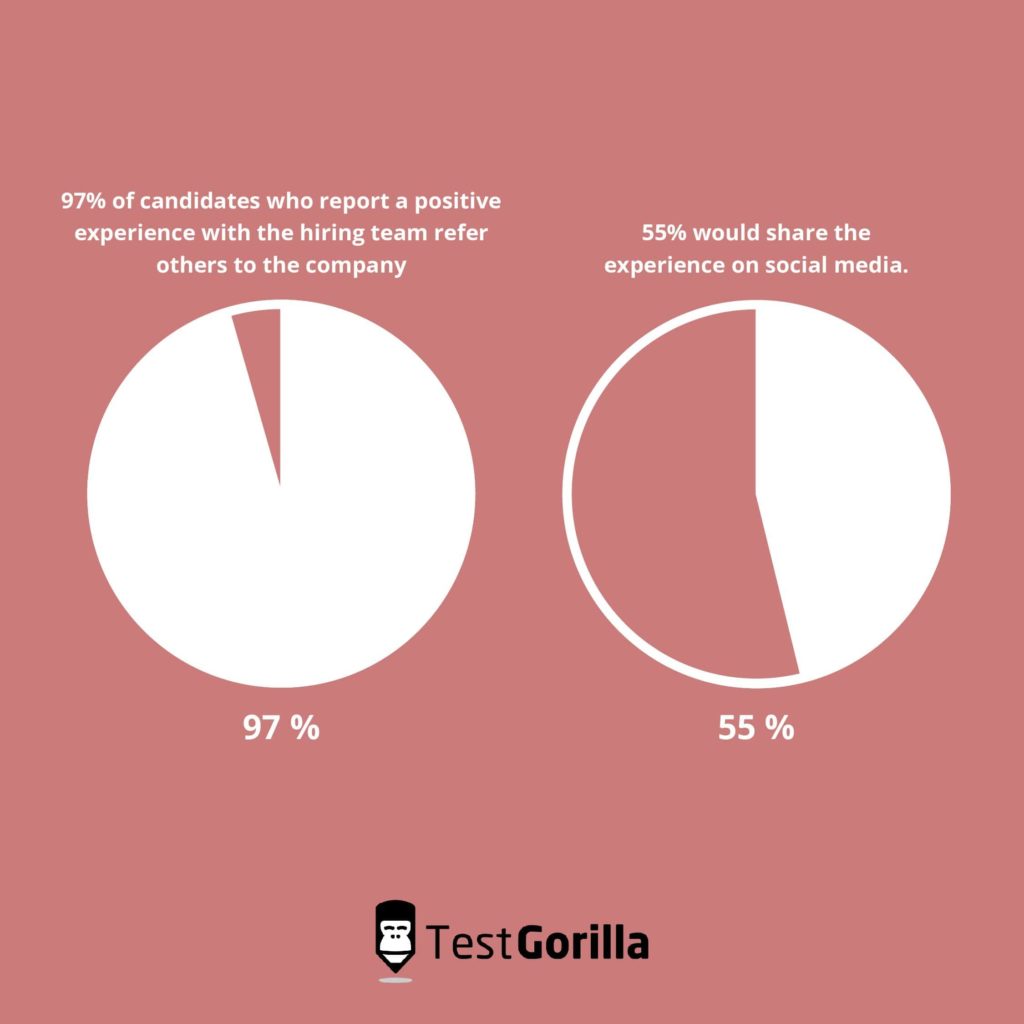It’s no secret…
The past few years forced change in every aspect of how we work, where we work, and which companies we work for.
Between advances in technology opening the door for remote work, the Great Resignation leaving 10.9 million jobs open, employees and job seekers bringing new demands to the table, and the rise of the creator economy, there’s a war for top talent going on.
HR professionals are facing a battle, now more than ever.
You need to prepare if you’re going to develop a recruiting strategy to attract top-talent candidates, retain the right workers, and stay up to date with the latest trends in hiring.
We’ve got you covered at TestGorilla. We’re here to provide accurate assessment tools that identify talent right from the start of the recruitment process.
We’ve compiled a list to help you identify top hiring priorities for the coming year and beyond.
1. Focus on your critical roles
Critical roles are roles that influence overall productivity, morale, efficiency, and profit.
But, how do you identify these? What do you prioritize? Where do you even start?
Well, for starters, there are critical roles at every level of an organization. So, if you answered roles at the top, you’re only partially correct.
It’s easy to think that way, but it’s not always true. In fact, 20% of critical roles can be three or more layers below the chief executive officer, and 20% more are brand-new roles.
And not all roles have the same importance, regardless of where they are in the organizational hierarchy.
Some openings, like a customer service agent, may be able to stay vacant longer than the sales team lead, for example. But you won’t know until you’ve defined the value of each role.
To implement a critical role identification strategy, consider these questions:
Which role is key for growth?
Which role is crucial for helping the company stay competitive?
Which role affects overall operations the most and the least?
Your answers to these questions reveal the value of each role and make it easy to identify the critical ones.
Another tip to gain insight into the value of each role is to engage management, who will have a better view of which roles are vital to overall performance in their department.
Here are some other questions to consider to prioritize critical roles in your hiring process:
How much strain is a vacant role putting on the rest of the team? Is the vacancy putting the team at risk of burnout?
How much is the unfilled role costing?
What skills are necessary – and not just desired – for the role?
How long can the organization operate effectively without filling the role?
Defining and focusing on critical roles first can ensure you are able to fill positions that are integral to the success of your company quickly and efficiently.
Now that you have identified which roles are critical, where do you start looking?
We’re glad you asked.
2. Look internally first
Just as critical roles are present at all levels, so too is talent.
Looking internally can be a lifesaver when it comes to filling open positions. An existing employee will already be familiar with the company and its values and ethics.
Giving existing employees the opportunity to apply before advertising externally shows your commitment to providing internal mobility opportunities, education, and overall consideration for the team. It shows that you prioritize your employees above outside hires and may even increase employee retention.
This is good for you and good for the team.
On the business end, an internal hire will:
Cost less
Take less time to onboard
Reduce hiring time
If you aren’t convinced that searching for candidates internally should be on your hiring-priorities list, consider this…
Even if current employees are not actively searching for new jobs, 68% would consider making a move.
Almost half (43%) of those currently employed are open to the opportunity of a new position, and 12% are actively looking for new jobs. Only 16% have no interest in changing roles.
Simply put, employees who didn’t leave their jobs throughout the pandemic or the Great Resignation probably would for the right opportunity. Capitalize on this existing opportunity by engaging in internal searches.
By including internal searches on your hiring-priorities list, you’ve already started to…
The best insights on HR and recruitment, delivered to your inbox.
Biweekly updates. No spam. Unsubscribe any time.
3. Build and refine your talent pipeline
How can you find top talent without a well-defined pool of potential?
You can’t – at least not efficiently.
A talent or candidate pipeline is a proactive measure for cutting down on job advertising time and costs, shortening the downtime between employees, and keeping top talent in an easily accessible funnel.
Qualified candidates who have been prescreened via assessment tools (more on this below) are stored in a database and available at your fingertips when it’s time to consider applicants for a new opening.
Take internal searching, as we mentioned. Perhaps there isn’t a good internal fit for the opening right now. But a few months down the road, a similar position opens up.
Having the screened internal candidates from the last round of hiring in the talent pipeline makes it easy to match a candidate to an opening.
For external hiring, let’s say you have a position with a high turnover rate (like a sales rep).
Every few months, you spend hours reposting the opening, combing through CVs and resumes, scheduling interviews, and doing all the leg work for a new hire.
And you do all of this while balancing a short-staffed team. It’s nothing short of a familiar HR nightmare.
You get the idea.
Building and maintaining a quality talent pipeline is a must-have on your hiring-priorities list if you’re looking to dominate the hiring landscape. This is talent acquisition made easy.
Develop a talent pipeline by:
Using skills-assessment tools
Leveraging social media
Nurturing candidates
Skills assessment
Anyone can put anything on a resume, but how do you know if they can deliver on those shiny bullet points and well-prepared interview responses?
The short answer is you don’t.
It’s hard to quantify the monetary cost of a bad hire, but in qualitative terms, the wrong hire can cost productivity, motivation, and morale and affect the whole organization.
That’s where prehiring and recruitment skills assessments come in. Assessing a candidate’s skill set ensures that they are truly qualified before you hire them, saving you costly mistakes in the long run.
What if you wanted to measure a candidate’s communication skills? Sure, they can say they’re a great communicator, but you wouldn’t know for sure until weeks or months after they were hired.
Put their resume bullet points to the test (literally) with a customizable communications assessment even before scheduling an interview.
Using skills-assessment tools to qualify candidates from the beginning keeps the talent pipeline full of available applicants for…
Talent rediscovery
Perhaps the last round of hiring was tough. Maybe the perfect candidate backed out at the last second for a different offer, or a long-time employee suddenly quit or was forced to retire.
With talent rediscovery, you can shorten the time needed to fill the open position by revisiting the pool of already qualified candidates.
And since they’re already in the talent pipeline and have been qualified through customizable industry or workplace culture assessment tools, you won’t waste time on advertising, screening, or digging through references.
Is this a good way to rediscover talent or what?
Leverage social media
Social media enables you to capitalize on the fact that 79% of job seekers already use social platforms to actively search for jobs. This number suggests that using social media should be a top priority in your recruitment process.
Advertising job openings through these channels can attract top candidates who may already follow you, are familiar with your organization, and are likely to align with your business philosophy.
LinkedIn works great for employee referrals, planning, and advertising networking events (webinars and in-person events) and increases reach for recruiting talent.
Additional ways you can leverage social media include searching for relevant hashtags (e.g., #marketing, #contentcreation, or #webdesign) on Twitter to find potential recruits. You can also use Facebook to search for and filter candidates based on different criteria – for example, those in New York with an MBA in finance.
Furthermore, once you’ve found top-talent candidates, social-media tools make it easy to…
Nurture qualified candidates
Qualified job seekers have many options in the current market. Keep your company at the top of a talented recruit’s mind by nurturing them.
Show that you’re serious and eager to have them on the team by sending a follow-up email, messaging them on social media, or giving them a call (while respecting their time, of course).
Here are a few quick, simple rules to follow when communicating with candidates:
Be honest
Be consistent
Be transparent
Be genuine
Nurturing potential candidates can set the tone for the workplace relationship right from the start.
Plus, it could help bolster your talent pipeline since 97% of candidates who report a positive experience with the hiring team refer others to the company, and 55% would share the experience on social media.
On the other hand, negative candidate experience cost Virgin Media $5.4m. This may be an extreme example, but it shows the type of adverse effects bad candidate experience can have.
Other sourcing tools for building a pipeline
Don’t forget to check under every internet rock when creating a hiring-priorities list by doing the following:
Use Boolean searches or people search
Look on portfolio websites, like Behance, Dribbble, or Contently
Check social sites like Meetup for industry-relevant events
Here’s a quick summary of what we just discussed.
Benefits | |
Skills assessments | Customize assessments specific to the job role; Identify key skills; Qualify applicants |
Talent rediscovery | Save time by revisiting previous applicants; Enhance the team |
Social media | Expand reach; Networking events; Advertising |
Nurture candidates | Create connection; Show company culture; Keep qualified candidates interested |
Other sources | Boolean or people search for advanced candidate pool searches; Portfolio websites in specific job roles to prescreen candidates before reaching out |
4. Stay committed to creating a bias-free workplace
We’d all like to think we aren’t biased, but implicit biases exist in all of us.
Because of that, diversity and inclusion (D&I) hiring initiatives aren’t just nice to have. They’re a must-have to stay competitive in recruiting and retaining top talent in today’s market.
In fact, 76% of job seekers and employees say a diverse workplace is a key consideration in job selection and whether or not they stay in their current position.
When implicit biases are not continually dismantled and there is no contingency plan to keep them in check across the team, new perspectives are ignored.
New perspectives drive innovation, and we all want to be on the leading edge of our industries.
Creating a bias-free workplace requires an awareness of unconscious biases across the team.
There are around 150 identified biases, but these five are most common in the workplace:
Affinity bias: the tendency to gravitate toward people who look like us
Halo effect: the tendency to believe everything about an individual is good because we like them as a person
Confirmation: the tendency to look for information that confirms our pre-existing beliefs
Groupthink: the tendency to mimic others to fit in
Perception: the tendency to make assumptions about individuals or groups, which makes it impossible to make objective decisions
Here are some examples of what these biases can look like in the workplace:
Selecting a candidate because you share an alma mater
Promoting an employee because you like them
Selecting a candidate because they are from your country of residence and you believe your country is better than others
Hiring a candidate because the rest of the team thinks they are the best fit, even if you do not
Hiring a candidate based on age, education, religion, race, neurodiversity, disabilities, gender, appearance (beauty, weight, height, etc.), socioeconomic status, or sexual orientation
Make a commitment to creating and maintaining a bias-free workplace one of the top priorities in your hiring process by:
Implementing open-dialogue practices and policies with potential new hires and existing employees. Aim to implement an open-door policy.
Considering and evaluating employee needs. You could give personal time off for religious holidays, family needs, or mental health, for example.
Regularly revisiting and updating the employee handbook on sexual harassment and no-tolerance behavior policies to reflect D&I.
Hosting regular, company-wide diversity training.
Crafting an inspiring D&I statement to show your company’s commitment to creating a diverse and inclusive workplace.
Implementing blind-hiring practices that remove a candidate’s personal information to decrease the risk of bias.
Create a company culture of “belonging for all.” To streamline all of this for your hiring-process priorities list…
5. Turn to HR technology for a helping hand
HR technology can be your greatest asset (and a competitive advantage) when it comes to creating a hiring-priorities list and streamlining company practices.
Applicant tracking systems are commonplace in most HR departments. You may already use Lever, Greenhouse, Workable, or a similar ATS. From managing job postings and advertising to storing applicants, the benefits of using an ATS are countless.
Gone are the days when hiring decisions were made based on the gut feelings of the HR professional. Intuition isn’t enough anymore when choosing the best candidate.
The right tools save time, money, and energy while optimizing human resources effectively.
HR tech platforms can help with:
Task automation
Data storage
Analytics
Onboarding
Team communication
Wage management
All of the above assist in making unbiased decisions.
A comprehensive tech stack should include an applicant tracking system (ATS), pre-employment assessments, and onboarding software.
That’s where we come in. Pre-employment assessments from TestGorilla are science-backed hiring tools that automatically screen for the best applicants.
We’ll recommend assessments based on the role you’re hiring for, and you can create your own as well.
Once an assessment is completed, the top candidates are ranked and readily available. Choose from soft or hard skills, include personality tests, see how a candidate aligns with company culture, and more right from the start.
Next is employee onboarding software.
Onboarding software familiarizes new hires with workplace policies, tracks information, and provides an overview of where a new hire is in the onboarding process. Welcome portals are the perfect place to store the D&I mission statements, by the way.
Another possible consideration for your HR tech stack is implementing a learning management system (LMS).
An LMS enables you to create and store customizable training material relevant to an industry, department, or role. You can also use it to deliver updated company-wide D&I training in real time.
Get your HR hiring tech stack in order before considering…
6. Other priorities
In March 2022, there was an average of 11,352 job openings in the US across all industries. With more openings than candidates, the red-hot job market is a job seeker’s paradise.
The bottom line is that top-talent candidates have a lot of choices and can afford to be selective. To compete when recruiting top talent, consider what you can offer an employee in return.
Some of the chief desires of job seekers today include:
Flexibility
Remote work and hybrid schedules
Better work-life balance
Comprehensive family care policies
Workplace culture
Remote work seems a bit like a cliche since work from home has become the norm over the past two years. But we’d like to still mention that having remote or hybrid work schedules available can open the door for outsourcing top-talent candidates who may have been excluded in the past.
Considering these factors can be a stop-gap practice that can prevent boomerang employees, keep you out of the cycle of always looking for talent, and create modern, well-rounded teams.
Plus, being transparent about what your organization brings to the table is a great way to show your company’s values and how much you value employees from the get-go.
Future-proof your hiring process
One last thing…
Work trends are dramatically changing in this post-pandemic world, and although no one can predict the future, you can prepare for it.
Here’s a handy table that recaps our six hiring process priorities to make sure your company is ready for hiring in the coming year and beyond.
Hiring-Priorities List | |
Focus on critical roles | Critical roles are at all levels; Find them by defining the value of each role |
Look internally first | Costs less; Quicker to onboard |
Build + refine talent pipeline | Use skills assessments, talent rediscovery, and social media, and nurture candidates; Streamline hiring and save time and money |
Bias-free workplace | Implement open dialogue; Company-wide diversity training; Update policies and handbooks; Create a D&I mission statement; Blind-hiring practices |
HR tech | ATS; Skills assessments from TestGorilla; Onboarding software; LMS |
Other hiring priorities | Consider job seeker and employee needs and demands; Outsourcing, remote work, and hybrid schedules; Work-life balance; Comprehensive family care policies |
Our suite of tests will help you identify and develop the critical skills necessary for success in your industry. Plus, our team of experts is always here to help you create tests that attract and retain top talent.
Check out TestGorilla’s assessment tools to get started (for free).
You've scrolled this far
Why not try TestGorilla for free, and see what happens when you put skills first.

















